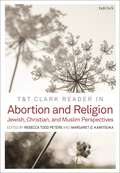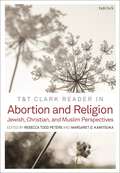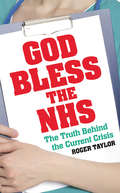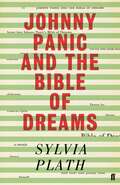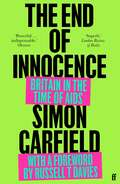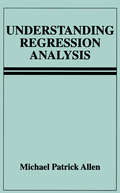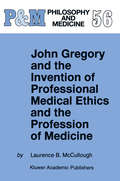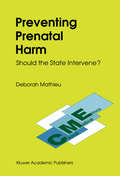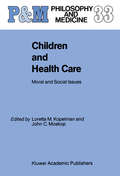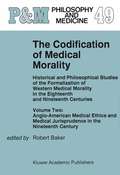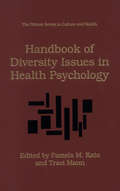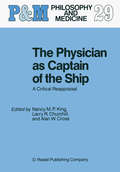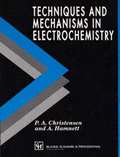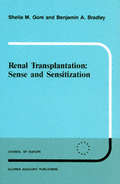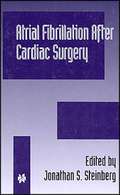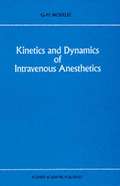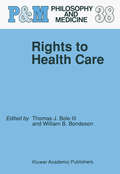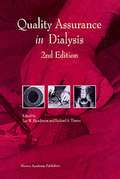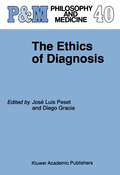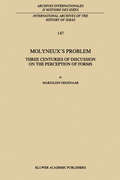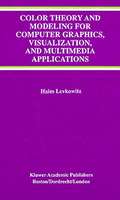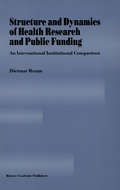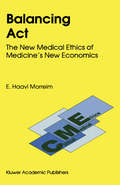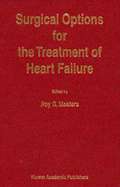- Table View
- List View
T&T Clark Reader in Abortion and Religion: Jewish, Christian, and Muslim Perspectives
by Rebecca Todd Peters Margaret D. KamitsukaThis volume introduces students to the history of cultural and theological responses to abortion as background for understanding a diversity of ethical positions in contemporary Christian, Jewish, and Muslim writings. Politicized debates about abortion are often presented in terms of a binary rhetoric of prolife versus prochoice; however, this collection of essays shows how that binary often breaks down when abortion is seen from different religious perspectives and in light of the voices of women themselves. While abortion is a global phenomenon, this volume focuses on the U.S. context. American abortion politics and culture wars have been dominated by Christian voices; nevertheless, Jewish and Muslim abortion ethics engage many of the same issues from different cultural and religious perspectives. Finally, this volume presents important examples of recent social scientific studies about the relationship of religion and abortion in the diverse cultural, racial, and economic fabric of American society.Pedagogical features include: - boxed text sections with primary sources - introductions to each part of the book - questions for a discussion - key terms in bold
T&T Clark Reader in Abortion and Religion: Jewish, Christian, and Muslim Perspectives
by Rebecca Todd Peters Margaret D. KamitsukaThis volume introduces students to the history of cultural and theological responses to abortion as background for understanding a diversity of ethical positions in contemporary Christian, Jewish, and Muslim writings. Politicized debates about abortion are often presented in terms of a binary rhetoric of prolife versus prochoice; however, this collection of essays shows how that binary often breaks down when abortion is seen from different religious perspectives and in light of the voices of women themselves. While abortion is a global phenomenon, this volume focuses on the U.S. context. American abortion politics and culture wars have been dominated by Christian voices; nevertheless, Jewish and Muslim abortion ethics engage many of the same issues from different cultural and religious perspectives. Finally, this volume presents important examples of recent social scientific studies about the relationship of religion and abortion in the diverse cultural, racial, and economic fabric of American society.Pedagogical features include: - boxed text sections with primary sources - introductions to each part of the book - questions for a discussion - key terms in bold
God Bless the NHS
by Roger TaylorThe National Health Service, described by Nigel Lawson as Britain's only 'national religion', has never been more popular. So why is the government so desperate to reform it? Last year, the Office of National Statistics reported higher public satisfaction with the NHS than at any time since its foundation. In a 2012 survey of developed countries, the UK showed the highest public support of its health system. Politicians can hardly be surprised then, when their plans to reforms are met with public dismay and professional fury. This year has seen one of the most bruising political battles ever fought over the future of the NHS. The twenty-two month fight to push the NHS and Social Care Act through parliament prompted the most widespread political campaign by doctors since Aneurin Bevan established the NHS in 1948. It cost the coalition government dearly and shredded the reputation of the Secretary of State for Health. So why did they do it? God Bless the NHS looks at the ideology behind the current reforms and the reasons why the government decided to take on the nation's most treasured institution. Roger Taylor looks equivocally at those who support and oppose the new system, and at the patchy history of attempts to reform the NHS and the likelihood of the success this time round. Finally, it addresses the political failure at the heart of the problem and the inevitable conflict when politics and medicine mix.
Johnny Panic and the Bible of Dreams: and other prose writings (P. S. Ser.)
by Sylvia PlathI lay there alone in bed, feeling the black shadow creeping up the underside of the world like a flood tide. Nothing held, nothing was left. The silver airplanes and the silver capes all dissolved and vanished, wiped away like the crude drawings of a child in coloured chalk from the colossal blackboard of the dark.The writings in this collection outline Plath's early preoccupation with issues of mental illness, creativity and femininity, all of which would become recurrent themes in her later work. They offer special insight into her development as a writer, and arguably paved the way for her only full-length piece of prose writing, the loosely veiled fictional autobiography, The Bell Jar.This second edition contains the thirteen stories included in the first edition together with five pieces of her journalism, as well as a few fragments from her journal; and a further nine stories selected from the Indiana archive.
Avalanche: A Love Story
by Julia LeighAt the age of thirty-eight, acclaimed novelist Julia Leigh made her first visit to the IVF clinic, full of hope. So started a long and costly journey of nightly injections, blood tests, surgeries, and rituals.Writing in the immediate aftermath of her decision to stop treatment, Leigh lays bare the truths of her experience: the highs of hope and the depths of disappointment, the grip of yearning and desire, the toll on her relationships, and the unexpected graces and moments of black humour. Along the way she navigates the science of IVF, copes with the impact of treatment, and reconciles the seductive promises of the worldwide multi-billion-dollar IVF industry with the reality.Avalanche is the book that's finally been written on IVF treatment: a courageous, compelling, and ultimately wise account of a profoundly important and widespread experience. At the heart of this work is an exploration of who and how we love. It is a story we can all relate to - about the dreams we have, defeated or otherwise, for ourselves, our loves, and our relationships.Avalanche bears witness to Leigh's raw desire, suffering, strength, and, in the end, transformation, and her shift to a different kind of love.
The End of Innocence: Britain in the Time of AIDS
by Simon Garfield** With a new introduction by Russell T Davies **A new edition of the award-winning, ground-breaking account of the early AIDS crisis in Britain.'A remarkable journalistic achievement.' Time Out'Powerful . . . Indispensable.' Observer'Superb.' London Review of BooksWinner of the Somerset Maugham PrizeHow does a country control a virus that is killing increasing numbers of people?How does a government contain an epidemic spread by sex, drug use and blood products?And how does a population react when told that everyone is at risk from infection?By 1986, when the British Government woke up to the problem of AIDS, it estimated that 30,000 people had already been infected with HIV. Why did it act so late? Would the situation have been different if most of those affected had not been gay men?Award-winning journalist Simon Garfield presents a story of political intrigue, of panic and hysteria, of wasted opportunities and of a medical battle conducted against seemingly impossible odds. Including interviews with key figures in the fight against the virus as well as those facing personal devastation and prejudice, The End of Innocence is an important and powerful story, compellingly told.Features a new afterword by the author.
Understanding Regression Analysis
by Michael Patrick AllenBy assuming it is possible to understand regression analysis without fully comprehending all its underlying proofs and theories, this introduction to the widely used statistical technique is accessible to readers who may have only a rudimentary knowledge of mathematics. Chapters discuss: -descriptive statistics using vector notation and the components of a simple regression model;-the logic of sampling distributions and simple hypothesis testing; -the basic operations of matrix algebra and the properties of the multiple regression model; -testing compound hypotheses and the application of the regression model to the analyses of variance and covariance, and -structural equation models and influence statistics.
John Gregory and the Invention of Professional Medical Ethics and the Profession of Medicine (Philosophy and Medicine #56)
by Laurence B. McCulloughThe best things in my Ufe have come to me by accident and this book results from one such accident: my having the opportunity, out of the blue, to go to work as H. Tristram Engelhardt, Jr. 's, research assistant at the Institute for the Medical Humanities in the University of Texas Medi cal Branch at Galveston, Texas, in 1974, on the recommendation of our teacher at the University of Texas at Austin, Irwin C. Lieb. During that summer Tris "lent" me to Chester Bums, who has done important schol arly work over the years on the history of medical ethics. I was just finding out what bioethics was and Chester sent me to the rare book room of the Medical Branch Library to do some work on something called "medical deontology. " I discovered that this new field of bioethics had a history. This string of accidents continued, in 1975, when Warren Reich (who in 1979 made the excellent decisions to hire me to the faculty in bioethics at the Georgetown University School of Medicine and to persuade Andre Hellegers to appoint me to the Kennedy Institute of Ethics) took Tris Engelhardt's word for it that I could write on the history of modem medical ethics for Warren's major new project, the Encyclopedia of Bioethics. Warren then asked me to write on eighteenth-century British medical ethics.
Preventing Prenatal Harm: Should the State Intervene? (Clinical Medical Ethics #3)
by D. Mathieu E. Haavi MorreimThe issues explored in this book have unfortunately come to be known as 'maternal-fetal conflicts'. The phrase is unsatisfactory because it is misleading: It places the emphasis on the well-being of the fetus instead of on the born child (who will bear the burden of any harm done prenatally); it assumes a conflict between a pregnant women and her offspring (while the issue is usually more complex and more broadly based); and it incorrectly implies that all pregnant women are appropriately regarded as mothers. For these reasons, I have chosen to avoid the phrase 'matern- fetal conflict' altogether, and will instead speak in terms of 'preventable prenatal harm'. I mention this at the outset, for those of you familiar with 'maternal-fetal conflicts' who might be wondering if I am addressing the same issues. Yes. But I am trying to look at them in a new - and I hope more fruitful - way. I would like to thank the other participants in the Hastings Center's maternal-fetal project - especially those who disageed with me - for being so thought-provoking. And I owe a lasting debt of gratitude to Henry Ruth and Allen Buchanan for their invaluable counsel.
Children and Health Care: Moral and Social Issues (Philosophy and Medicine #33)
by Loretta M. Kopelman John C. MoskopBefore a separate Department of Medical Humanities was formed, the editors of this volume were faculty members of the Department of Pediatrics at our medical school. Colleagues daily spoke of the moral and social problems of children's health care. Our offices were near the examining rooms where children had their bone-marrow procedures done. Since this is a painful test, we often heard them cry. The hospital floor where the sickest children stayed was also nearby. The physicians, nurses, and social workers believed that children's health care needs were not being met and that more could and should be done. Fewer resources are available for a child than for an adult with a comparable illness, they said. These experiences prompted us to prepare this volume and to ask whether children do get their fair share of the health care dollar. Since the question "What kind of health care do we owe to our children?" is complex, responses should be rooted in many disciplines. These include philosophy, law, public policy and, of course, the health professions. Representing all of these disciplines, contributors to this volume reflect on moral and social issues in children's health care. The last hundred years have brought great changes in health care tor children. The specialty of pediatrics developed during this period, and with it, a new group of advocates for children's health care. Women's suffrage gave a political boost to the recognition of children's special health needs.
The Codification of Medical Morality: Historical and Philosophical Studies of the Formalization of Western Medical Morality in the Eighteenth and Nineteenth CenturiesVolume Two: Anglo-American Medical Ethics and Medical Jurisprudence in the Nineteenth Century (Philosophy and Medicine #49)
by Robert Baker Dorothy Porter Roy PorterLike many novel ideas, the idea for this volume and its predecessor arose over lunch in the cafeteria of the old Wellcome Institute. On an atternoon in Sept- ber 1988, Dorothy and Roy Porter, and I, sketched out a plan for a set of conf- ences in which scholars from a variety of disciplines would explore the emergence of modern medical ethics in the English-speaking world: from its pre-history in the quarrels that arose as gentlemanly codes of etiquette and honor broke down under the pressure of the eighteenth-century "sick trade," to the Enlightenment ethics of John Gregory and Thomas Percival, to the American appropriation process that culminated in the American Medical Association's 1847 Code of Ethics, and to the British turn to medical jurisprudence in the 1858 Medical Act. Roy Porter formally presented our idea as a plan for two back-to-back c- ferences to the Wellcome Trust, and I presented it to the editors of the PHI- LOSOPHY AND MEDICINE series, H. Tristram Engeihardt, Jr. and Stuart Spicker. The reception from both parties was enthusiastic and so, with the financial backing of the former and a commitment to publication from the latter, Roy Porter, ably assisted by Frieda Hauser and Steven Emberton, - ganized two conferences. The first was held at the Wellcome Institute in - cember 1989; the second was sponsored by the Wellcome, but was actually held in the National Hospital, in December 1990.
Handbook of Diversity Issues in Health Psychology (The Plenum Series in Culture and Health)
by TraciMann Pamela M. KatoThe field of health psychology has grown dramatically in the last decade, with exciting new developments in the study of how psychological and psychosocial processes contribute to risk for and disease sequelae for a variety of medical problems. In addition, the quality and effectiveness of many of our treatments, and health promotion and disease prevention efforts, have been significantly enhanced by the contributions of health psychologists (Taylor, 1995). Unfortunately, however, much of the theo rizing in health psychology and the empirical research that derives from it continue to reflect the mainstream bias of psychology and medicine, both of which have a primary focus on white, heterosexual, middle-class American men. This bias pervades our thinking despite the demographic heterogeneity of American society (U. S. Bureau of the Census, 1992) and the substantial body of epidemiologic evidence that indicates significant group differences in health status, burden of morbidity and mortality, life expectancy, quality of life, and the risk and protective factors that con tribute to these differences in health outcomes (National Center for Health Statistics, 1994; Myers, Kagawa-Singer, Kumanyika, Lex, & M- kides, 1995). There is also substantial evidence that many of the health promotion and disease prevention efforts that have proven effective with more affluent, educated whites, on whom they were developed, may not yield comparable results when used with populations that differ by eth nicity, social class, gender, or sexual orientation (Cochran & Mays, 1991; Castro, Coe, Gutierres, & Saenz, this volume; Chesney & Nealey, this volume).
The Physician as Captain of the Ship: A Critical Reappraisal (Philosophy and Medicine #29)
by Nancy M. P. King Larry R. Churchill Alan W. Cross"The fixed person for fixed duties, who in older societies was such a godsend, in the future ill be a public danger." Twenty years ago, a single legal metaphor accurately captured the role that American society accorded to physicians. The physician was "c- tain of the ship." Physicians were in charge of the clinic, the Operating room, and the health care team, responsible - and held accountabl- for all that happened within the scope of their supervision. This grant of responsibility carried with it a corresponding grant of authority; like the ship's captain, the physician was answerable to no one regarding the practice of his art. However compelling the metaphor, few would disagree that the mandate accorded to the medical profession by society is changing. As a result of pressures from a number of diverse directions - including technological advances, the development of new health professionals, changes in health care financing and delivery, the recent emphasis on consumer choice and patients' rights - what our society expects phy- cians to do and to be is different now. The purpose of this volume is to examine and evaluate the conceptual foundations and the moral imp- cations of that difference. Each of the twelve essays of this volume assesses the current and future validity of the "captain of the ship" metaphor from a different perspective. The essays are grouped into four sections. In Section I, Russell Maulitz explores the physician's role historically.
Techniques and Mechanisms in Electrochemistry
by P.A. Christensen A. HamnetIt is hard to overstate the importance of electrochemistry in the modern world: the ramifications of the subject extend into areas as diverse as batteries, fuel cells, effluent remediation and re-cycling, clean technology, elect- synthesis of organic and inorganic compounds, conversion and storage of solar energy, semiconductor processing, material corrosion, biological electron transfer processes and a wide range of highly specific analytical techniques. The impact of electrochemistry on the lives of all of us has increased immeas- ably, even in recent years, but this increase has not been reflected in the level or content of courses taught at universities, many of which portray the subject as a collection of arcane recipes and poorly understood formulae of marginal importance to the mainstream of chemistry. This approach reached its nadir with the recent extraordinary furore surrounding the purported discovery of cold fusion, where two electrochemists claimed to have shown that the fusion of deuterium nuclei could be effected under ambient conditions by the electrochemically induced intercalation of deuterium atoms into palladium. Whatever the truth behind such claims, their discussion revealed a lamentable lack of knowledge of modern elect- chemistry, not only among science writers for the popular press, but among many professional chemists and physicists whose acquaintance with the subject seems, for the most part, to have stopped somewhere about the time of Nernst. In a year in which Professor R.
Renal Transplantation: Sense And Sensitization (Developments in Nephrology #21)
by S.M. Gore B.A. BradleyIn 1986, the Committee of Experts on Blood Transfusion and Immunohae- tology of the Council of Europe chose for their Programme of Co-ordinated Research "An investigation of the procurement and sharing of transplantable organs for potential recipients who are highly sensitized to HLA-antigens". This topic was of common concern to all centres practising renal transplan- tion. The terms of reference of the study were: To estimate the number of patients who are virtually "untransplantable" because of high sensitization in each European country. To study the nature of immunization in terms of the type and specificity of antibodies present in the blood and techniques used for their detection. To investigate possible practical solutions - both current and future, invo- ing cross-matching procedures, the circulation of reference material from patients, and the willingness of the national organizations to share resources. 4. To explore other methods of resolving this problem. Although the study did not offer the prospect of a brilliant new insight into the problem of high sensitization, it was unique in several ways: for the first time we saw all European organizations collaborating in a common project to provide information on their activities, their problems and the methods to resolve them; it introduced, for this subject, relatively novel statistical methods to investigate susceptibility to sensitization and factors affecting transplant outcome; it enabled a large database of transplanted highly sensitized patients and matched controls to be assembled, that would have been unavailable as a research resource at any single centre.
Atrial Fibrillation after Cardiac Surgery (Developments in Cardiovascular Medicine #222)
by Jonathan S. SteinbergCardiac surgery is performed on hundreds of thousands of patients a year, and can have an important beneficial impact on the outcomes of patients with coronary and valvular heart diseases. Despite the favorable recovery of most patients, some will have their post-operative period interrupted by the development of atrial fibrillation, with a host of potential complications including stroke. High risk subgroups may develop atrial fibrillation in more than half of cases, and often despite aggressive prophylactic measures. Treatment of atrial fibrillation and its aftermath can also add days to the hospital stay of the cardiac surgical patient. In an era of aggressive cost cutting and optimization of utilization of health care resources, the financial impact of this arrhythmic complication may be enormous. Experimental studies have led to a greater understanding of the mechanism of atrial fibrillation and potential precipitating factors in the cardiac surgical patient. Prophylactic efforts with beta-blockers, antiarrhythmic drugs and atrial pacing are being used, or are being investigated in clinical trials. New methods of achieving prompt cardioversion with minimal disruption of patient care, and prevention of the thromboembolic complications of atrial fibrillation, are also important therapeutic initiatives. This text is designed to aid health care professionals in the treatment of their patients in the recovery period after cardiac surgery, and to instigate additional research efforts to limit the occurrence of, and the complications following, this tenacious postoperative arrhythmia.
Kinetics and Dynamics of Intravenous Anesthetics (Developments in Critical Care Medicine and Anaesthesiology #26)
by G.M. WoerleeMany drugs used in current anesthetic practice are administered intravenously. An appreciation of their kinetics and dynamics is of great assistance in determining the most appropriate drug to use, and optimal dosage regimens for any given patient. This book is specially oriented to the requirements of anesthesiologists. It will enable the student of those subjects to gain enough knowledge to make these subjects usable in daily anesthetic practice. As such it is intermediate in difficulty between mathematically oriented texts, and those which only offer a very qualitative understanding of these subjects. Practical applications and examples of the uses to which kinetic and dynamic principles can be put in daily practice are emphasized and illustrated. Basic principles and techniques with which the reader can perform kinetic and dynamic calculations are explained simply and demonstrated in detail using examples derived from clinical practice. Two appendices provide kinetic and dynamic data on the most commonly used anesthetic drugs. The last chapters use the principles discussed in the first chapters to show how variations of normal physiology and disease affect drug kinetics and dynamics. This is especially valuable to the clinician as it enables clinically useful, albeit qualitative, predictions to be made of the direction of any change of kinetic and dynamic parameters of drugs due to these factors.
Rights to Health Care (Philosophy and Medicine #38)
by Thomas J. Bole III W.B. BondesonHuman existence is marked by pain, limitation, disability, disease, suffering, and death. These facts of life and of death give ample grounds for characterizing much of the human condition as unfortunate. A core philosophical question is whether the circumstances are in addition unfair or unjust in the sense of justifying claims on the resources, time, and abilities of others. The temptation to use the languages of rights and of justice is und- standable. Faced with pain, disability, and death, it seems natural to complain that "someone should do something", "this is unfair", or "it just isn't fight that people should suffer this way". Yet it is one thing to complain about the unfairness of another's actions, and another thing to complain about the unfairness of biological or physical processes. If no one is to blame for one's illness, disability, or death, in what sense are one's unfortunate circumstances unfair or unjust? How can claims against others for aid and support arise if no one has caused the unfortunate state of affairs? To justify the languages of fights to health care or justice in health care requires showing why particular unfortunate circumstances are also unfair, in the sense of demanding the labors of others. It requires understanding as well the limits of property claims. After all, claims regarding justice in health care or about fights to health care limit the property fights of those whose resources will be used to provide care.
Quality Assurance in Dialysis (Developments in Nephrology #39)
by L. W. Henderson Richard S. ThumaIn examining the preface of our first book, it is increases needed. The Deming philosophy empha apparent that the editorial comments made in sizes that quality is never fully achieved: process 1994 are even more pertinent in today's cost- improvement is never ending. constrained healthcare environment than when But, what is quality? Without defining, David first written. We repeat them in part. Garvin makes the point that "in its original form, This is a time in history when the concept of quality activities were reactive and inspecti- quality is reaching new highs in terms of public oriented; today, quality related activities have awareness. Articles describing quality, CQI, qual broadened and are seen as essential for strategic ity tools, critical success factors, failures, and success" [1]. How can the broad context of quality lessons learned appear in local newspapers, trade be applied to the diverse aspects of ESRD? journals, scientific periodicals, and professional Furthermore, although far from a new concept, publications on a daily basis, yet implementation Continuous Quality Improvement (CQI) has taken of a quality system in many hospital units is its place as a dominant theme in many industries. approached with caution and the basic tenants of CQI is more broadly applicable, both in concept quality systems and CQI continue to be misunder and execution, to service as well as manufacturi- stood. based operations.
The Ethics of Diagnosis (Philosophy and Medicine #40)
by José Luis PesetA major focus of the philosophy of medicine and, in general, of the philosophy of science has been the interplay of facts and values. Nowhere is an evaluation of this interplay more important than in the ethics of diagnosis. Traditionally, diagnosis has been understood as an epistemological activity which is concerned with facts and excludes the intrusion of values. The essays in this volume challenge this assumption. Questions of knowledge in diagnosis are intimately related to the concerns with intervention that characterize the applied science of medicine. Broad social and individual goals, as well as diverse ethical frameworks, are shown to condition both the processes and results of diagnosis. This has significant implications for bioethics, implications that have not previously been developed. With this volume, `the ethics of diagnosis' is established as an important branch of bioethics.
Molyneux’s Problem: Three Centuries of Discussion on the Perception of Forms (International Archives of the History of Ideas Archives internationales d'histoire des idées #147)
by M. DegenaarSuppose that a congenitally blind person has learned to distinguish and name a sphere and a cube by touch alone. Then imagine that this person suddenly recovers the faculty of sight. Will he be able to distinguish both objects by sight and to say which is the sphere and which the cube? This was the question which the Irish politician and scientist William Molyneux posed in 1688 to John Locke. Molyneux's question has intrigued a wide variety of intellectuals for three centuries. Those who have attempted to solve it include Berkeley, Reid, Leibniz, Voltaire, La Mettrie, Condillac, Diderot, Müller, Helmholtz, William James and Gareth Evans. This book is the first comprehensive survey of the history of the discussion about Molyneux's problem. It will be of interest to historians of both philosophy and psychology.
Color Theory and Modeling for Computer Graphics, Visualization, and Multimedia Applications (The Springer International Series in Engineering and Computer Science #402)
by Haim LevkowitzColor Theory and Modeling for Computer Graphics, Visualization, and Multimedia Applications deals with color vision and visual computing. This book provides an overview of the human visual system with an emphasis on color vision and perception. The book then goes on to discuss how human color vision and perception are applied in several applications using computer-generated displays, such as computer graphics and information and data visualization. Color Theory and Modeling for Computer Graphics, Visualization, and Multimedia Applications is suitable as a secondary text for a graduate-level course on computer graphics, computer imaging, or multimedia computing and as a reference for researchers and practitioners developing computer graphics and multimedia applications.
Structure and Dynamics of Health Research and Public Funding: An International Institutional Comparison
by Dietmar BraunBy gathering institutional details on funding and health research systems in a comparative perspective, Structure and Dynamics of Health Research and Public Funding offers, for the first time, a comprehensive and systematic view of the options and restrictions to which scientists, clinicians and administrators are subject when seeking to establish a productive health research enterprise. The Structure and Dynamics of Health Research and Public Funding provides the reader with a comparative institutional analysis of problems of application in health research. In assessing the cognitive, social and institutional structuring of health research, explanations for the origin and variation of problems are presented. The study extensively discusses the capacities of funding agencies to contribute to a higher practical diffusion of health research knowledge. It is thus addressed to all individuals and institutions who are involved in the promotion of, or are concerned with, the future of health research.
Balancing Act: The New Medical Ethics of Medicine’s New Economics (Clinical Medical Ethics #3)
by E. Haavi MorreimMedicine's changing economics have already fundamentally, permanently altered the relationship between physician and patient, E. Haavi Morreim argues. Physicians must weigh a patient's interests against the legitimate, competing claims of other patients, of payers, of society as a whole, and sometimes even of the physician himself. Focusing on actual situations in the clinical setting, Morreim explores the complex moral problems that current economic realities pose for the practicing physician. She redefines the moral obligations of both physicians and patients, traces the specific effects of these redefined obligations on clinical practice, and explores the implications for patients as individuals and for national health policy. Although the book focuses on health care in the United States, physicians everywhere are likely to face many of the same basic issues of clinical ethics, because every system of health care financing and distribution today is constrained by finite resources.
Surgical Options for the Treatment of Heart Failure (Developments in Cardiovascular Medicine #225)
by Roy G. Masters MD FRCSCDespite the significant decline in heart disease mortaht>' rates over the last 25 years, heart failure has remained a significant problem. We are now confronted with large numbers of terminally ill patients for whom conventional therapies for heart failure have been exhausted and for whom repeated hospital visits are necessary. There now is a major thrust towards a management strategy which embraces a comprehensive approach including vigorous preventive measures and earlier surgical interventions. This book outlines the major surgical options for the treatment of heart failure and brings together a very broad base of opinions with contributions from several outstanding individuals. With the improved knowledge and techniques to control rejection, transplantation has become the central pillar in the surgical management of this group of patients. Unfortunately, because of limited donor supply the teclmique cannot be applied to large numbers of patients. A great deal of excitement, however, exists in the potential for xenotransplantation as a supplement to homotransplantation. The use of cardiac assist devices has become a reality with several hundred LVADS and BiVADS implanted throughout the world and cardiac replacement with total artificial hearts continues to be used successfully as a bridge to transplantation. We are on the thieshold of the broad application of assist devices to provide prolonged relief of heart failure and restore patients to an ambulatoiy home environment and hopefully return to the work force in significant numbers.
